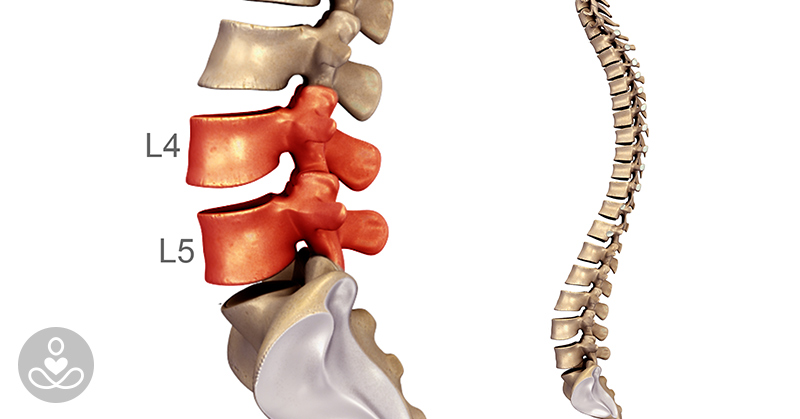Lower back pain? You may have heard your practitioner mention something about your L4-L5 spinal segment. The lower back (lumbar spine) is a fairly complex structure. It consists of 5 vertebrates, the lowest is the L4-L5. This section of the spine is responsible for supporting the upper body and allowing fluid movement in multiple directions. Your lumbar spine is also negatively impacted by sitting for extended periods of time.
As with many other body parts, the lower back is capable and prone to developing pain from injury or degenerative changes, some of which include:
- A herniated disc. Your L4-L5 disc, in between the vertebrae is the most likely to herniate. When this happens, the inner portion can leak out and touch a nearby nerve root, causing pain to radiate in the lower back and/or down the leg (sciatica)
- Two joints known as facet joints (or zygapophyseal joints) are prone to osteoarthritis, which is a common cause of lower back pain pain in people over age 60.
- L4-L5 spondylolisthesis: Weakness in the bones, joints, and ligaments of the spine can lead to the L4 vertebra slipping forward over the L5 vertebra impinging the nerve root and leading to leg pain and other symptoms.
Treatment for the L4-L5
Non-operative solutions are involved in most cases of L4-L5 pain. Only severe cases that are unresponsive to treatments and may have lead to disability would be considered for surgery. In many scenarios, people either live with the pain (so to speak), or they find other modalities to overcome it.
Back Pain Treatments for Relief:
- Heat or ice. The application of a cold pack or heating pad may help to relieve lower back pain. Most people find that alternating between the two works best.
- Manual manipulation. This treatment may be applied by a chiropractor, osteopathic doctor, or other qualified health professional. This thought to relieve lower back pain by reducing pressure on sensitive structures, increasing flexibility, improving blood flow and reducing muscle tension.
- Therapeutic massage. Massage therapy is thought to improve blood flow, reducing muscle stiffness, and decrease stiffness.
- Exercise. A program of back exercises and physical therapy will usually include a combination of strengthening, stretching, and low-impact aerobic exercise.
- Yoga. Work with a certified teacher and let them know the pain you’re experiencing, they will be able to provide modifications to support you. Stretching and lengthening movements are often what your lower back needs, so don’t be afraid to give it a try.
- Lifestyle factors. Many lifestyle changes are also important in reducing lower back pain, such as quitting smoking, weight loss, activity modification, and improved ergonomics and posture.
Sources
- All About the L4-L5 Spinal Segment https://www.spine-health.com/conditions/spine-anatomy/all-about-l4-l5-spinal-segment?fbclid=IwAR1ISTEvxTTQ7Zsfd7nrBYYR4Y58khXkMAVBD6IhUJBldBraM_Xqa8LjLtQ
- Back Pain Medication Overview: Understanding Medication for Back Pain Relief https://www.spine-health.com/conditions/lower-back-pain/back-pain-medication-overview-understanding-medication-back-pain-relief
- Non-Surgical Treatments for Lower Back Pain https://www.spine-health.com/conditions/lower-back-pain/non-surgical-treatments-lower-back-pain

